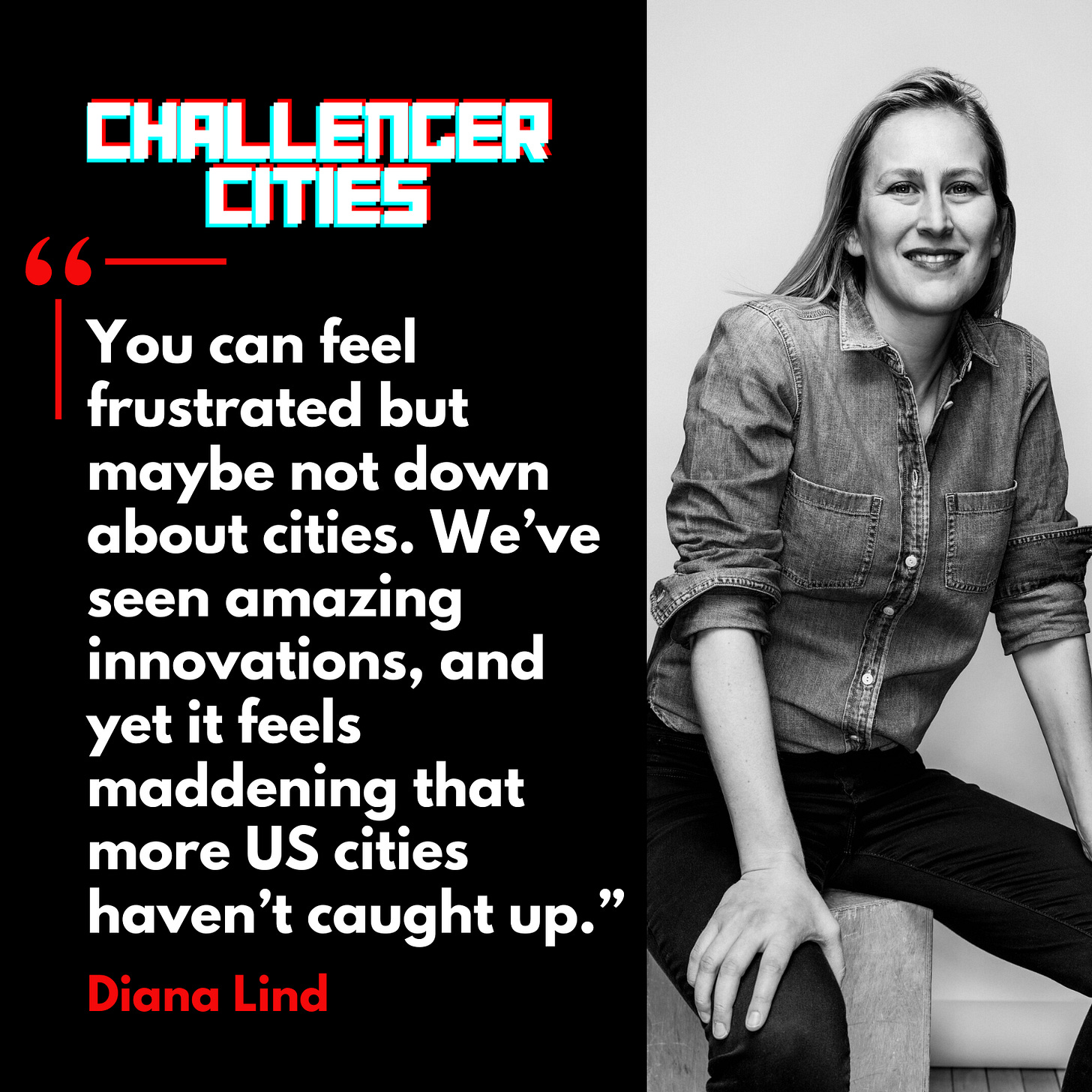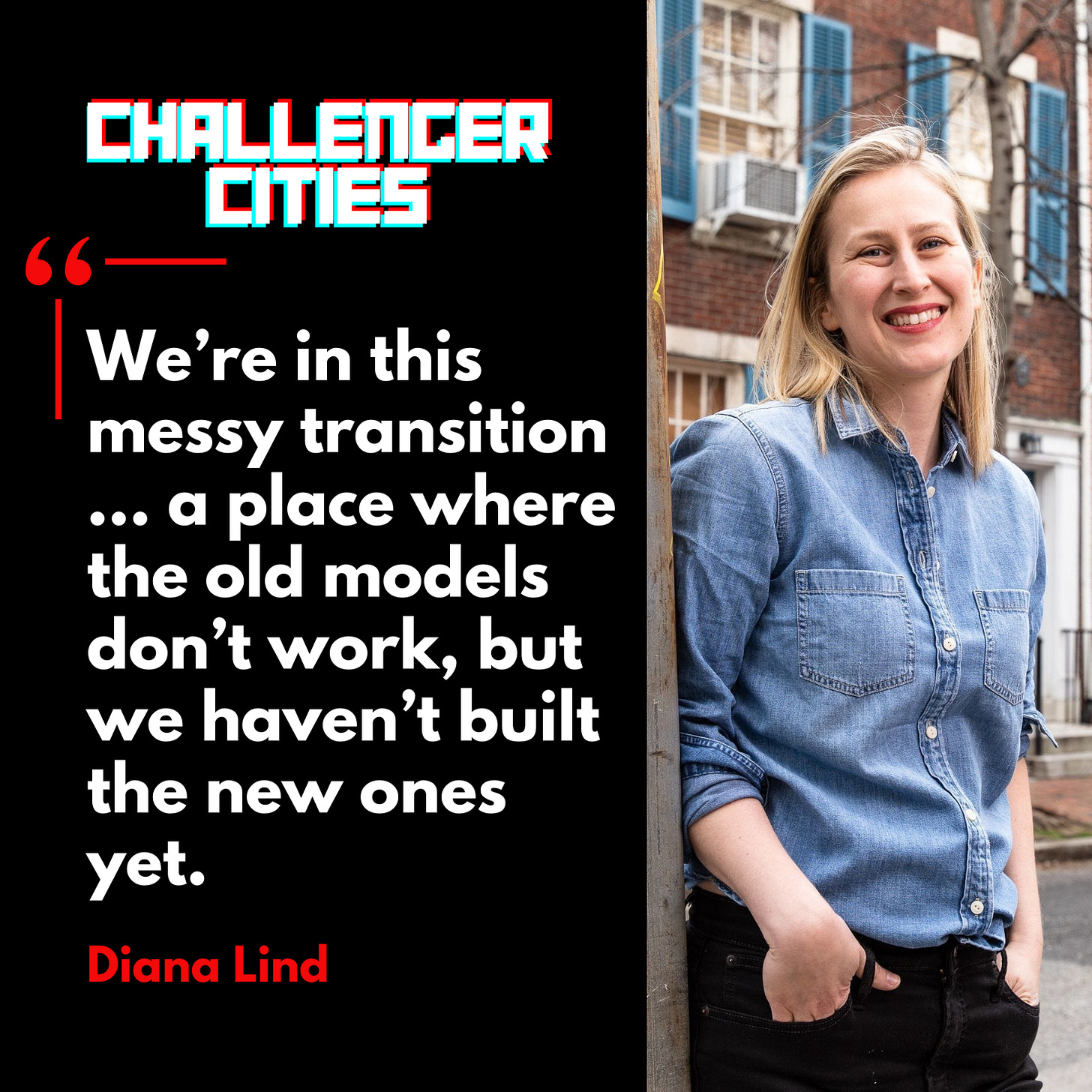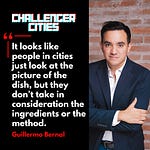“Right now we’re in the not very exciting part of the digital takeover,” Diana Lind tells me, somewhere between amusement and frustration. “Everyone shops online and visits stores just to feel a fabric or try something on. It’s the worst of both worlds. Retail could be so much more experiential.”
It’s an observation that really resonates to me. For we like to tell ourselves we live in a moment of transformation, yet here’s Diana, author, editor, and chronicler of urban life for more than two decades, calling out the hollow centre of our urban evolution. The pandemic was meant to redraw the map of our cities. Instead, we’ve drifted into an in‑between state, not quite the brave new world we imagined, but no longer the city of old either.
As the author of Brave New Home and the voice behind The New Urban Order on Substack, Diana has been mapping this shifting conversation since long before it was fashionable. She started out writing about architecture and urban design when the field was still defined by glossy renderings and cautious optimism. Since then, she’s watched cities ride out booms, busts, cultural renaissances and political reckonings. Only to arrive at 2025 in what she calls “a messy transitional phase we’ve barely begun to make sense of.”
It’s this tension between optimism and exasperation that runs through our conversation.
The Optimism–Frustration Paradox
Diana’s perspective is shaped by personal history. She grew up in Manhattan in the 1980s and ’90s, the New York of Seinfeld, Friends and a thousand cultural touchstones that sold the idea of city life as a heady mix of grit and glamour. “Sometimes I’m disappointed by what New York has become … much more digitally focused, much less spontaneous,” she admits. “But I still find so much to explore. Cities can still reach their full potential.”
This is the paradox of the contemporary city. In a way, we’ve raised our standards. We want our urban cores to be safer, more beautiful, more alive … but that comes with costs, literally and metaphorically. “People’s standards have really been raised, what they feel like they need to feel safe in a city, to feel excited enough to do things in person. That has really changed and it’s really expensive.”
Homogenisation, Starbucks and Raising the Floor
We talk about the ‘cloning’ of cities, from Brooklyn‑inspired bars in Minneapolis, cookie‑cutter coffee shops in once distinct neighbourhoods — and whether it’s always a bad thing. “It can feel sad when something doesn’t represent the place you’re in. But replication is often how investment works. People want to replicate what worked somewhere else rather than try something completely new,” she reflects.
Her Starbucks anecdote illustrates the point.
“When the first Starbucks opened in my neighbourhood, I was so mad. But a local coffee shop owner told me: ‘Starbucks made it acceptable to sell a $3 coffee. Our business thrived because Starbucks was here.’”
It’s a provocative way to think about urban homogenisation. Starbucks doesn’t raise the ceiling, you won’t have the best coffee of your life there, but it does raise the floor. It creates a baseline of quality and safety that makes space for independents to flourish. That, Diana argues, is exactly what downtowns need: “If the urban core isn’t offering something more interesting than the suburbs, then what’s the competitive advantage? Downtowns need to raise the bar.”
From ‘Starter Homes’ to Something Aspirational
Housing dominates Diana’s recent writing, and it’s easy to see why. Zoning, affordability, and density are no longer fringe topics. They’re central to whether our cities survive as meaningful places.
“We’re in a totally different place now … zoning reform is finally a real conversation happening in every city. Seven years ago, it wasn’t.” She points to Minneapolis, which legalised four-plexes in most neighbourhoods, as a rare American success story: “It’s kept prices low with much less appreciation than in other cities.”
But she’s quick to remind me that building codes and zoning are only part of the story. The deeper challenge is cultural. We talk about the loaded term ‘starter home’. “Calling it a starter home feels like a letdown,” she says. “It’s appropriate for a 28‑year‑old in 1970, but in 2025, when people are buying their first homes at 38? We need something more aspirational that fits how people live today.”
Her point is you can’t sell density on the rational logic in spreadsheets or of moral duty. You need to show people that a well‑designed 1,300‑square‑foot house or a smartly planned apartment is desirable in its own right. “People need to see things to actually believe they want them,” she insists. In much of North America, this simply hasn’t been the case. Even the American tourists who might admire the exterior of European apartment buildings, haven’t really seen that they can be fantastic spaces on the inside too.
Co‑Living and What We Don’t Like to Talk About
Before the pandemic, co‑living felt like it was on the cusp of being the next big urban idea. “It was compelling for a generation who wanted experiences over things,” Diana recalls. “But it died off during the pandemic. The business model never quite worked with investor expectations.”
Yet co‑living hasn’t really disappeared, it’s sort of just underground. Diana points to models like PadSplit, which convert living and dining rooms into extra bedrooms, effectively doubling the capacity of small homes. “It’s bare‑bones but affordable. Some people don’t want more than that — they just need something safe and accessible.” Meanwhile it’s something you’ll see a lot of as collectives, often immigrant friends, are competing for single family units and repurposing the space to suit their situation.
It’s a reminder that there’s a difference between what we imagine urban housing should look like and what the market, especially its most vulnerable participants, is already doing. “People don’t like to admit it, but there’s already an underground economy of shared housing,” Diana says.
Who Runs the Curb?
If Diana has a mantra for where cities go next, it’s this … create the roles to manage transformation. Too often, cities attempt systemic change with outdated toolkits. or worse, with no one truly accountable for the things that matter most. “Controlling the curbs determines so much of how cities work,” she says, referencing Boston’s decision to appoint a Director of Curb Management. This is something that way back in my consulting career I had explored with a tech firm too.
It can sound small in theory, but in practice it affects everything from delivery congestion to pedestrian safety, from outdoor dining to public transit efficiency. “We can’t just assume autonomous vehicles or delivery tech will arrive and our old systems will handle it. We need people empowered to rethink these fundamental urban assets,” Diana argues.
It’s not just about the curb either. Diana believes cities need a new class of roles; cross‑sector, problem‑solving positions that reflect how interdependent the urban system has become. Someone to align housing policy with economic development, someone to connect retail strategy with public transit access, someone to plan for a digital economy that doesn’t gut physical space. “Transformation won’t happen if we only think in silos,” she says.
It’s an approach that asks cities to grow up, to stop papering over structural issues with pop‑up interventions and pilot programs that can become zombies, and instead build institutional muscle for the long haul.
The Magic Wand
At the end of our conversation, I ask her the Challenger Cities ‘magic wand’ question. No rules, no budgets, no politics … what would you change tomorrow?
“I’d make urban public education the envy of the world,” Diana answers instantly. “Better funded, better staffed, with better buildings. That would transform everything.”
It’s an answer that cuts to the heart of urban inequality. If schools are safe, excellent and aspirational, they reshape the entire ecosystem: who moves to a city, who stays, who invests, and who thrives. “If urban public schools were better funded, better staffed, had better buildings … that would change everything,” she says.
(i must admit here, that live, I totally misunderstood this response, and thought Diana meant making Urbanism educations, the envy of the world … like instead of going to Business school, you’d go to a place where you learn how to make great cities … so yeah, my bad and you’ll pick that up if you listen to the full episode.)
It’s also a reminder that the things that make cities desirable are often the least glamorous. A transit network might get you to work faster, but a brilliant school for the kids keeps you rooted. A restaurant scene might put your neighbourhood in a magazine, but an inspiring public school builds the next generation who will keep that neighbourhood alive.
The Boring Bit Before the Breakthrough
Diana leaves me with a simple, uncomfortable truth. For all our talk of innovation, we’re still failing to make cities feel as inspiring, liveable and exciting as they could be. The pandemic was supposed to be a reset, an opening for reimagining urban life, but much of the change has stalled in pilot programs, policy papers and wish lists.
People’s expectations for cities have changed dramatically, but we haven’t caught up with that reality. “We’re in this messy transition … a place where the old models don’t work, but we haven’t built the new ones yet”, Diana reflects.
That’s the real challenge I think Diana is putting to city leaders. Can we get out of this limbo? Can we stop mistaking temporary fixes for structural change? Can we build the political and cultural will to invest in what makes cities magnetic again?
It won’t come from copying what worked elsewhere. It will come from cities bold enough to create their own playbooks, to experiment, take risks and reimagine themselves without apology. It’s why Diana’s writing resonates to me too, for she’s not just chronicling what cities are, but asking what they might dare to become.
To being Challengers.
















Share this post